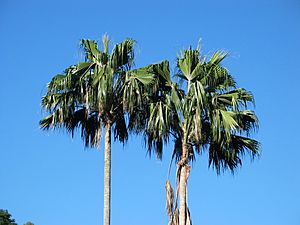Nihoa pritchardia facts for kids
Quick facts for kids Nihoa pritchardia |
|
|---|---|
 |
|
| Conservation status | |
| Scientific classification | |
| Genus: |
Pritchardia
|
| Species: |
remota
|
The Nihoa fan palm, also known as Pritchardia remota or Loulu, is a special type of palm. It naturally grows only on the small island of Nihoa in Hawaiʻi. Later, some were moved to the island of Laysan.
This palm is smaller than many other Pritchardia palms. It usually grows to be about 4 to 5 meters (13 to 16 feet) tall. Its trunk is about 15 centimeters (6 inches) wide. It used to be the only tree found on Nihoa and was very common.
In 1885, a big wildfire swept across Nihoa. This fire destroyed most of these palms. Today, only about 700 of these trees are left. This makes the Nihoa fan palm an endangered species. However, their numbers are slowly growing. People are also growing these palms in special botanical gardens to help protect them.
It's easy to spot the Nihoa fan palm on Nihoa because it's the only tree there. But if you compare it to other Pritchardia palms, you can tell it apart. Look for its wavy leaves. Its flower clusters (called inflorescences) are short and smooth. Its tiny, round fruits are also a good clue.
A similar type of palm once lived on Laysan island. Sadly, it became extinct after the island was mined for guano (bird droppings).
Contents
Where the Nihoa Fan Palm Lives
In 1996, experts counted about 680 Nihoa fan palms on the island of Nihoa. These palms grow in groups in two valleys. They prefer damp, coastal areas. The biggest group is in West Palm Valley. Three smaller groups are found in East Palm Valley.
Long ago, palms similar to the Nihoa fan palm were very common on the main Hawaiian islands. This was before the year 1000. As more people lived there, they cleared the trees. They used the land for farming. They also used the wood for building and for fires.
Ancient Uses and Challenges
People who lived on Nihoa long ago likely used these palms a lot. This might have caused problems with their water supply. The water could have become dirty from guano. Also, there were several dry years because of a weather pattern called El Niño. These tough conditions might have made the people leave Nihoa. They likely returned to the main Hawaiian islands. This happened before Europeans discovered Nihoa in the 1700s.
The Nihoa fan palm also faces dangers from flash floods. These floods can happen in the lower part of Nihoa's East Palm Valley. This is one of the places where the palms grow.
Animals and the Palm
The Nihoa fan palm provides a home for some birds. Red-footed boobies build their nests in these palms. Brown noddies also like to perch on the palm trees.
Images for kids
See also
 In Spanish: Pritchardia remota para niños
In Spanish: Pritchardia remota para niños



